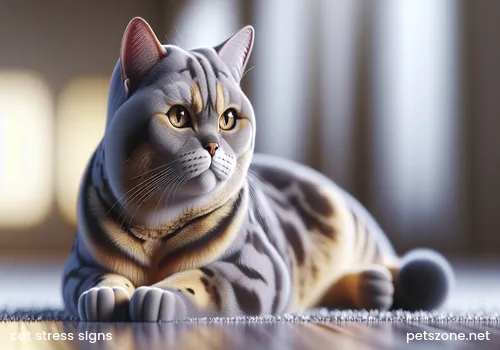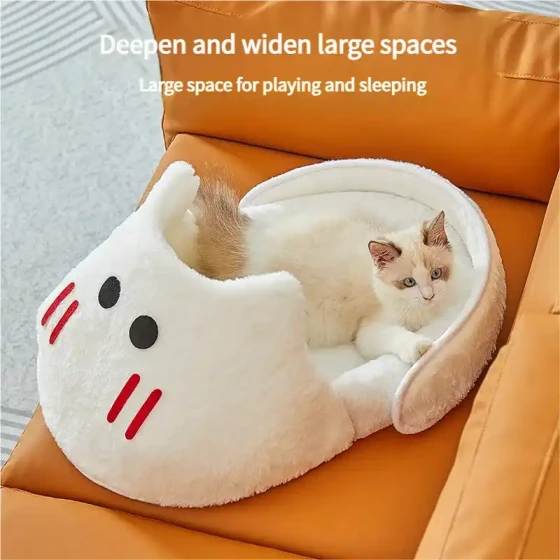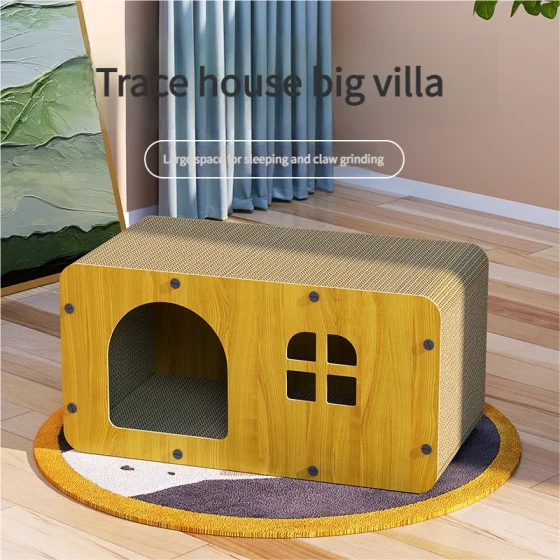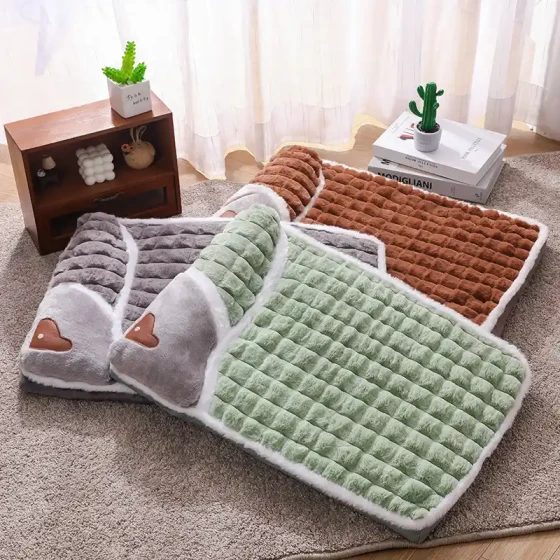Manifestations of Cat Stress Response_How to Determine Whether a Cat Is in a Stress State
The manifestations of cat stress responses are diverse and can be reflected in behavior as well as impact physical health. Understanding how to determine whether a cat is in a stress state is crucial for maintaining their happiness and health. Simply put, if your cat shows behavior or physical symptoms that differ from usual, especially when there are changes in the environment or daily routine, it is likely experiencing stress.

Cats, as animals with a strong sense of territory, heavily depend on stable and predictable environments. Any disruption to the routine or changes that bring uncertainty may become a source of their stress. Just like humans feel anxious when facing unknown or uncontrollable situations, cats exhibit similar emotional reactions. Understanding cat stress manifestations is an important step to becoming a responsible "pooper scooper" (cat owner).
Common Manifestations of Cat Stress Response
To determine if a cat is stressed, mainly observe changes in their behavior and physical condition. The following are some common stress signals:
1. Behavioral Changes:
- Increased Hiding Behavior: This is one of the most common stress signs. If your cat suddenly likes hiding under the bed, inside cabinets, or other concealed places and is unwilling to socialize, it may indicate feelings of insecurity or fear.
- Appetite Changes: Stress can cause a cat's appetite to decrease or even stop eating entirely, or cause overeating due to anxiety.
- Changes in Elimination Habits: Eliminating outside the litter box (urinating or defecating inappropriately) is a typical sign of cat stress. This may be due to dissatisfaction with the stressor or marking territory to gain a sense of security. Changes may also occur in urine frequency or amount.
- Excessive Licking/Grooming: Cats lick themselves to relax, but if licking becomes excessive or frequent, leading to red skin or hair loss, this is a strong stress manifestation medically called "psychogenic alopecia."
- Increased Aggressiveness or Clinginess: Some cats become irritable and prone to scratching or biting people or other pets when stressed; others become unusually clingy, seeking their owner’s comfort.
- Changes in Vocalization: Stressed cats may produce unusual sounds, such as continuous howling, low growling, or become unusually quiet.
- Reduced Play or Exploration Desire: A normally lively cat suddenly losing interest in toys and unwilling to explore the environment may be stressed.
2. Physical Changes:
Stress affects not only behavior but may also trigger various physical problems. Long-term or severe stress suppresses a cat’s immune system, making them more prone to illness.
- Digestive Issues: Stress may cause cats to experience vomiting, diarrhea, and other digestive problems.
- Urinary System Issues: Lower urinary tract diseases in cats, especially Feline Interstitial Cystitis (FIC), are closely related to stress. Stress may cause frequent urination, blood in urine, difficulty urinating, and symptoms can recur even without bacterial infection due to stress.
- Weight Changes: Appetite changes directly lead to weight loss or gain.
- Depression/Somnolence: Stress may make cats feel fatigued, appear lethargic, spend most of their time sleeping, and show reluctance to move.
How to Determine Whether a Cat Is in a Stress State
To judge if a cat is stressed, you need to observe carefully like a detective.
- Understand Your Cat’s Normal State: Every cat has its unique personality and habits. First, be clear about what your cat is like when it is in a normal and relaxed state. Where do they like to sleep? How much do they eat daily? What kind of interaction do they prefer?
- Observe Behavioral Changes: Compare your cat’s current behavior with their usual state. Are they hiding more than usual? Has their appetite changed? Are urination and defecation normal? Any excessive grooming?
- Review Recent Stressors: Reflect on whether there have been changes recently at home or in your cat’s life. For example:
- Environmental Changes: Moving, new family members (people or pets), furniture layout changes, new smells (renovation, new cleaning products).
- Daily Changes: Owner’s work schedule changes, irregular feeding times, litter box type or location changed, litter brand changed.
- Social Changes: Tense relationships with other pets, being alone for long periods.
- Noise: Continuous construction noise, loud sounds.
- Illness or Pain: Physical discomfort itself is a major stress source.
- Rule Out Medical Issues: This is very important as many stress symptoms (loss of appetite, vomiting, diarrhea, urination problems) may be caused by underlying diseases. Therefore, if you notice any of these physical symptoms or persistent abnormal behaviors, take your cat to the vet immediately. The veterinarian will conduct a thorough exam to exclude diseases. If organic diseases are ruled out, the vet may determine the behavior changes are stress-related.
Why Do Cats Get Stressed?
Cat stressors are varied, sometimes even trivial things unnoticed by us. Common stressors include but are not limited to:
- Environmental changes (moving, renovation)
- Changes in household members (new people, babies, other pets)
- Social conflicts (poor relations with other cats or pets)
- Boredom or lack of stimulation
- Irregular daily routines
- Dissatisfaction with litter box, litter, or feeding location
- Pain or illness
- Noise fears (thunder, fireworks)
- Traveling or vet visits
Harms of Long-Term Stress
Long-term stress is very harmful to cats’ health. Besides the behavioral and physical issues mentioned, chronic stress lowers immunity and increases disease risk, such as recurrent FIC, skin diseases, etc. Ongoing psychological pressure also reduces a cat’s well-being and quality of life.
How to Help a Stressed Cat
Once confirmed that a cat is stressed, understanding the cause and taking steps to alleviate stress is crucial. Common relief methods include:
- Provide a Safe, Enriched Environment: Offer enough hiding places (cardboard boxes, tunnels, cat trees), high platforms, scratching posts, toys, giving cats a sense of choice and control.
- Maintain a Regular Routine: Set fixed times for feeding, playing, and interaction.
- Reduce Stressors: If possible, minimize or eliminate factors causing your cat’s stress.
- Use Pheromone Products: Cat pheromone diffusers or sprays can help cats feel relaxed and safe.
- Increase Interaction and Play: Spend time in positive interaction with your cat, use play to expend energy and divert attention.
- Consult a Veterinarian or Animal Behaviorist: For severe stress, vets may recommend medication or refer to professional behaviorists for behavior modification programs.
Frequently Asked Questions
- How long does it take for cats to recover from stress? Recovery time varies depending on the individual cat, type and duration of the stressor, and the relief measures taken. Mild stress may resolve within days, while severe or long-term stress may take weeks or months to improve.
- Will cat stress resolve on its own? Occasionally, mild stress can adjust itself, but often, especially with clear behavioral or physical symptoms, stress will not improve on its own. Without intervention, it may worsen or lead to more serious health issues. Timely action or professional help is essential when signs of cat stress are detected.
In summary, paying attention to your cat’s behavioral and physical changes, understanding potential stressors they face, and taking appropriate interventions promptly is key to helping them maintain mental and physical health. If you cannot identify the cause or symptoms worsen, always seek professional veterinary help.




-560x560.webp)
-560x560.webp)